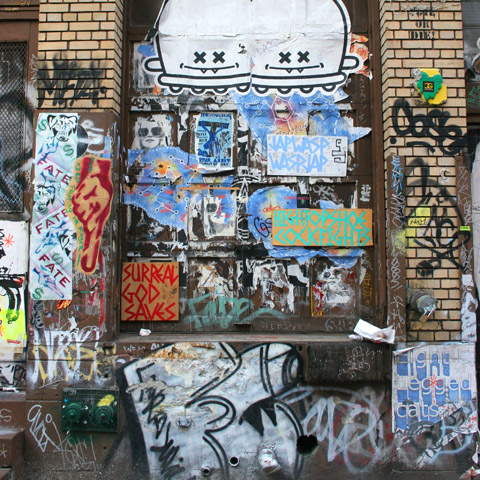William Gibson on graffiti
January 22, 2007 on 11:21 pm | In related links | Comments Off on William Gibson on graffiti
The Candy Factory, November 27, 2005
William Gibson, the original poet of cyberpunk, looks at “the mellowness of weathered, multi-level graffiti” and is reminded of “some endangered species of moss”. I love this comparison, as I’ve always seen graffiti as a kind of living thing with its own ecosystem. The particular graffiti he’s looking at is on the surface of a building known as the Candy Factory, not too far from 11 Spring Street. Above is a photo of the same spot taken just over a year ago.
This isn’t the first time graffiti has figured in Gibson’s world. A reader in the forums pointed out that there’s a description in All Tomorrow’s Parties of an actual living tag made of smart paint, which battles against graffiti-eating bots embedded in the wall itself. How soon before life imitates art?
Full Gibson quote below the fold.
From William Gibson’s All Tomorrow’s Parties:
The store on Sunset had had a finish that ate graffiti. The gang kids would come and tag it; twenty minutes later these flat, dark, vaguely crablike patches of dark blue would come gliding around the corner. Rydell had never understood how they worked, and Durius said they’d been developed in Singapore. They seemed to be embedded, a few millimeters down into the surface, which was a sort of non-glossy gel-coat affair, but able to move around under there. Smart material, he’d heard that called. And they’d glide up to the tag, whatever artfully abstract scrawl had been sprayed there to declare fealty or mark territory or swear revenge (Durius had been able to read these things and construct a narrative out of them) and start eating it. You couldn’t actually see the crablegs move. They just sort of nuzzled in and gradually the tag started to unravel, de-rez, molecules of paint sucked down into the blue of the Lucky Dragon graffiti-eaters.
And once someone had come with a smart tag, a sort of decal they’d somehow adhered to the wall, although neither Rydell nor Durius had been able to figure how they’d done it without being seen. Maybe, Durius said, they’d shot it from a distance. It was the tag of a gang called the Chupacabras, a fearsome spiky thing, all black and red, insectoid and menacing and, Rydell thought, kind of good-looking, exciting-looking. He’d seen it worn as a tattoo, in the store. The kids who wore it favored those contacts, the kind gave you pupils like a snake’s. When the graffiti-eaters came out after it though, it had moved.
They’d edge up to it, and it would sense them and move away. Almost too slow to see it happening, but it moved. Then the graffiti-eaters would move again. Durius and Rydell watched it, the first night, get all the way around to the back of the store. It was starting to work its way back around toward the front when they went off shift.
Next shift it was still there, and a couple of standard spray-bomb tags as well. The graffiti-eaters were locked on the smart tag and not taking care of business. Durius showed it to Mr. Park, who didn’t like it that they hadn’t told him before. Rydell showed him where they’d logged it in the shift record when they clocked off, which had just pissed Mr. Park off more.
About an hour later, two men in white Tyvek coveralls showed up in an unmarked, surgically clean white van and went to work. Rydell would’ve liked to watch them get the smart tag off, but there was a run of shoplifters that night and he didn’t get to see what they did to it. They didn’t use scrapers or solvents, he knew that. They used a notebook and a couple of adhesive probes. Basically, he guessed, they reprogrammed it, messed with its code, and after they left, the graffiti-eaters were back out there, slurping down the latest Chupacabra iconography.
I can’t help but wonder at the association between graffiti and gangs in this text. Is Gibson, one of my literary heroes, a victim of the same dangerous misconception that all graffiti is somehow gang-related? Does he really believe it’s all about “fealty, territory, or revenge”? Or is this bleak view of graffiti only there to add a splash of noir to his imagined future?
No Comments yet
Sorry, the comment form is closed at this time.
Entries and comments feeds.
Valid XHTML and CSS. ^Top^
51 queries. 0.603 seconds.
Powered by WordPress with theme based on jd-nebula design by John Doe.